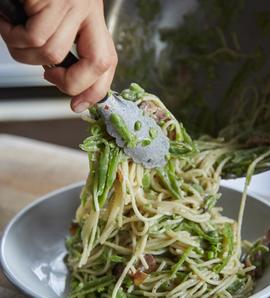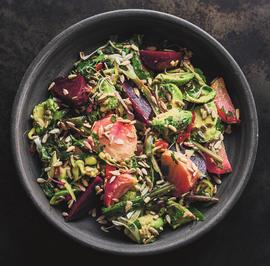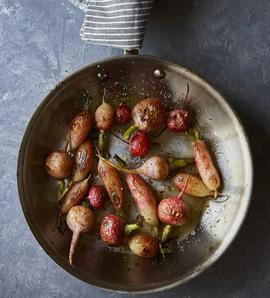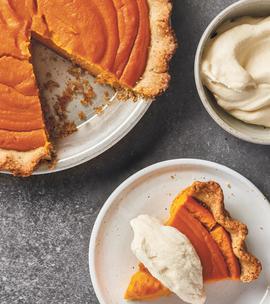Joshua McFadden grew up in Wisconsin and fell in love with food, farming and the seasons. After culinary school and jobs at top restaurants nationwide, he spent an influential two years on a farm in Maine. There he learned how to bring out the best in fresh produce – something he does at Portland, Oregon’s Ava Gene’s and Tusk. He also teaches it in his first cookbook, “Six Seasons: A New Way With Vegetables,” which won the James Beard Award for Best Vegetable Focused Cookbook.
Here are some of McFadden’s signature recipes:
Pasta alla Gricia with Slivered Sugar Snap Peas

Laura Dart/A.J. Meeker
Pasta alla gricia is a very simple Roman pasta dish consisting of guanciale (cured pork jowl) and pecorino. As I do with many traditional Italian dishes, I use the classic as a springboard for improvisation. Here I add very thinly sliced snap peas, which creates an amazing texture as well as adds a fresh green note to the otherwise quite rich pasta. And I use my Cacio e Pepe Butter (recipe follows) as a perfect shortcut, once again demonstrating that a well-stocked larder means delicious food in minutes.
Serves 4
Ingredients
Kosher salt and freshly ground black pepper
3 ounces guanciale or pancetta, diced or chopped
Extra-virgin olive oil
8 ounces spaghetti, fettuccine, or tagliatelle
1 pound sugar snap peas, strings pulled off, peas very thinly sliced on a sharp angle (so they’re almost shredded)
6 tablespoons Cacio e Pepe Butter (recipe follows)
Pecorino Romano cheese, for grating
Directions
- Bring a large pot of water to a boil and add salt until it tastes like the sea.
- Put the guanciale and 2 teaspoons olive oil into a skillet or Dutch oven that’s large enough to hold all the pasta. Cook until it’s lightly crisped and most of the fat has rendered out, 9 to 12 minutes. Take the skillet off the heat and spoon off the fat except for about 1 tablespoon.
- When the water is boiling, add the pasta and cook according to the package directions until almost al dente. When the pasta is almost ready, add the snap peas to the pasta pot.
- Put the skillet back over medium heat to reheat the guanciale gently. With a ladle or a measuring cup, scoop out about 1/2 cup of the pasta cooking water. Drain the pasta and snap peas and add them to the skillet along with the cacio e pepe butter. Toss well to incorporate, adding a few drops of the pasta water in order to make a cloaking, creamy sauce. Taste and adjust with more salt or pepper, though you probably won’t need any.
- Transfer to serving bowls and top with grated pecorino. Serve right away.
Cacio e Pepe Butter
The inspiration for this butter comes from the classic Roman pasta dish of spaghetti with Pecorino Romano cheese and black pepper. I put those two ingredients — plus some Parmigiano to mellow the bite of the pecorino a bit — into a butter, which you can keep in your fridge for weeks.
Makes about 1 1/2 cups
Ingredients
2 tablespoons black peppercorns
3/4 cup finely grated Pecorino Romano cheese
3/4 cup finely grated Parmigiano-Reggiano cheese
1/2 pound unsalted butter, at room temperature
- Put the peppercorns in a small skillet and toast over medium heat, shaking the pan or stirring constantly to toast the pepper evenly, just until you begin to smell a black pepper perfume, 2 to 3 minutes, depending on your skillet. Pour the pepper into another container and let cool completely.
- Crack and grind the pepper, either in a spice grinder (or a coffee grinder you dedicate to spices) or with a mortar and pestle. It’s nice to have uneven consistency, from fine to coarse.
- Fold the pepper and both cheeses into the butter with a wooden spoon or rubber spatula and pile into whatever container you want to serve or save it in.
- Chill the butter for at least 1 hour to firm it up and to let the flavors marry and permeate the butter.
Couscous with English Peas, Apricots, and Lamb Meatballs

Laura Dart/A.J. Meeker
The ingredients list looks long, but the meatballs are very easy to assemble. To make ahead: The night before, prep all the vegetables, herbs, and dried fruit, and cook the couscous and the meatballs. When it’s time to fix dinner, bring the couscous up to room temperature, toss in the goods, and gently reheat the meatballs in a low oven, covered. Ideally, your peas will be so fresh and young that they need no cooking, but if they taste starchy, blanch them in boiling salted water for about 1 minute.
Serves 4
Ingredients
Yogurt sauce
1 cup plain whole-milk or low-fat yogurt (not Greek)
3 scallions, trimmed (including 1/2 inch off the green tops), finely sliced on a sharp angle, soaked in ice water for 20 minutes, and drained well
1/4 cup chopped mint leaves
1 small garlic clove, minced
1/4 teaspoon dried chile flakes
Kosher salt and freshly ground black pepper
Couscous
8 dried apricots, cut into bits
1/4 cup white wine vinegar or red wine vinegar
1/4 cup warm water
1 cup couscous
Juice of 1/2 lemon
Extra-virgin olive oil
Kosher salt and freshly ground black pepper
3 large scallions, trimmed (including 1/2 inch off the green tops), sliced on a sharp angle, soaked in ice water for 20 minutes, and drained well
1/2 cup lightly packed mint leaves
2 pounds English peas in their pods, shelled (2 cups peas)
1/2 cup roughly chopped toasted almonds
Meatballs
1 pound ground lamb
3 scallions, trimmed (including 1/2 inch off the green tops), finely chopped
1/4 cup lightly packed chopped mint leaves
1 teaspoon ground cumin
1 1/2 teaspoons kosher salt
1/8 teaspoon cayenne pepper
1 tablespoon dry white wine
1/4 cup soft fresh breadcrumbs
Extra-virgin olive oil
1 egg
Directions
- For the yogurt sauce: Stir together the yogurt, scallions, mint, garlic, chile flakes, and salt and black pepper to taste in a small bowl. Taste and adjust the chile flakes, salt, and black pepper. Let the sauce rest for at least 30 minutes so the flavors can develop.
- For the couscous: Put the apricots in a small bowl with the vinegar and water. Soak until they are plumped, at least 30 minutes, then drain thoroughly.
- Hydrate and fluff the couscous. Add the lemon juice and 1/4 cup olive oil, and season generously with salt and pepper. Toss thoroughly and let cool to room temperature.
- Add the apricots, scallions, mint, shelled peas, and almonds. Toss lightly, taste for seasoning, and add more salt, pepper, lemon, or olive oil. Set aside.
- For the meatballs: Heat the oven to 450°F.
- Break the ground lamb into smallish chunks and put in a large bowl. Sprinkle the scallions, mint, cumin, salt, cayenne, wine, and breadcrumbs over the meat. Gently work the ingredients to blend them, by pushing and folding with your fingers. You want to be as gentle as possible in order to not make tough, compact meatballs. Once the ingredients are mostly blended, take a small spoonful of the mixture and fry it in a small skillet or pot. Taste the cooked sample for seasoning, then add more of whatever is needed, especially salt. You want the meatballs to be quite savory and highly seasoned.
- Once you’ve adjusted the seasoning, whisk a small glug of olive oil and the egg together, pour it over the meat, and work it in using the same gentle method.
- Divide the meat into 4 piles, then divide each pile into 4, and shape each piece into a nice ball (to make a total of 16 meatballs). Arrange all the meatballs on a rimmed baking sheet (to catch any fat or juices during cooking).
- Bake the meatballs until they are no longer pink in the center, 8 to 10 minutes (test one by gently prying it apart . . . you can just press it back together to serve).
- To serve, divide the couscous among 4 large shallow bowls. Top each portion with 4 meatballs and a nice drizzle of yogurt sauce. Pass more sauce at the table.
Roasted Beets, Avocado, and Sunflower Seeds

A.J. Meeker
The pepperoncini and sunflower seeds make this like a “salad bar” salad, though the similarity stops there. I always use beet tops, in the same way I like to use radish tops (provided they’re in good shape). I give them a quick sauté and a brief marination, then toss them into the dish.
Serves 4
Ingredients
1 pound beets, ideally with pristine greens attached
Kosher salt and freshly ground black pepper
Extra-virgin olive oil
3 tablespoons red wine vinegar
1/4 cup salted roasted sunflower seeds
1/2 cup lightly packed roughly chopped flat-leaf parsley leaves
4 scallions, trimmed (including 1/2 inch off the green tops), sliced on a sharp angle, soaked in ice water for 20 minutes, and drained well
1/2 cup lightly packed seeded, chopped pickled peppers, such as pepperoncini
2 firm-ripe avocados
Directions
- Heat the oven to 375°F.
- Trim the tops and bottoms off the beets. Wash the greens and spin dry in a salad spinner. Rinse and scrub the beets to remove any mud or grit. Cut up any larger beets so that they are all about the same size.
- Put the beets in a baking dish that’s large enough to accommodate all of them in a single layer.
- Season with salt, then pour 1/4 cup water into the dish. Cover tightly with foil and steam-roast until the beets are tender when pierced with a knife. Depending on the size, density, and age of the beets, this could take between 30 minutes and 1 hour.
- Meanwhile, if you have beet greens to cook, heat a medium skillet over medium heat. Add a glug of olive oil, add the beet greens, and toss them until they are wilted and a bit stewed, about 5 minutes. Set aside until cool, then chop through them a few times.
- When the beets are tender, let them cool until you can handle them, then rub or pare away the skins. Cut into 1/2-inch wedges or chunks and pile into a bowl. Add the greens.
- While the beets are still warm, sprinkle with the vinegar, 1/2 teaspoon salt, and many twists of black pepper. Toss to distribute the seasonings and let the beets absorb the vinegar for a few minutes. Add a healthy glug of olive oil and toss again. Let the beets sit at room temperature until you’re ready to serve.
- To assemble for serving, add the sunflower seeds, parsley, scallions, and pickled peppers and toss gently. Peel the avocados and cut them into neat chunks that are about the same size as the beet wedges, and add them to the beets, too. Toss thoroughly but very gently, so you don’t mash the avocado too much. Taste and adjust with more salt, black pepper, vinegar, or oil.
- Serve right away.
Roasted Radishes with Brown Butter, Chile, and Honey

Laura Dart/A.J. Meeker
Raw radishes and fresh butter are a classic pairing, but here we cook the two together until toasty and nutty. A splash of vinegar, a pinch of chile, and a drizzle of honey create a delicious tension that makes this dish unexpectedly satisfying.
Serves 4
Ingredients
Extra-virgin olive oil
2 bunches radishes, with their tops if they’re nice and fresh, radishes halved lengthwise if large
Kosher salt and freshly ground black pepper
Dried chile flakes
2 tablespoons unsalted butter
2 tablespoons red wine vinegar
2 tablespoons honey
Directions
- Heat the oven to 375°F.
- If you’re using the greens, cut them from the bunch of radishes and wash well in cool water, as you would salad greens. Once they’re hiding no more grit, spin them dry in a salad spinner.
- Put a small slick of olive oil in a large ovenproof skillet and heat over medium-high heat.
- Arrange the radishes cut side down and cook until lightly browned, about 3 minutes. Transfer to the oven and roast until the radishes are nicely browned and starting to get tender, about 10 minutes.
- Add the radish greens and roast until the radishes are fully tender and the greens have wilted, another 5 minutes.
- Take the skillet from the oven and set over low heat on the stove (careful, the handle is hot!). Season nicely with salt, black pepper, and 1/2 teaspoon chile flakes. Add the butter and cook until the butter has melted and is starting to get golden brown and nutty smelling, 2 to 3 minutes.
- Add the vinegar to the skillet and gently fold everything to combine. Drizzle on the honey and fold again. Taste and adjust the seasoning with more salt, black pepper, chile flakes, vinegar, or honey. Serve warm.
Carrot Pie in a Pecan Crust

AJ Meeker
I eat a lot of carrots—by themselves, pickled, in salads, grilled, in cake—and so why not in a pie? The pie has a soft, delicate texture reminiscent of a pumpkin pie (though the slices won’t hold their shape as well as pumpkin pie), but it’s distinctly carrot and deliberately not too sweet. The pecan crust adds a touch of richness.
Make one 9-inch pie (serves 6 to 8)
Ingredients
2 pounds carrots (about 6 large), trimmed, peeled, and cut into 1-inch chunks
Kosher salt
1/2 cup sugar
1 1/2 cups heavy cream or crème fraîche
2 tablespoons unsalted butter
2 eggs
1 egg yolk
Pecan Dough (recipe follows)
Directions
- Put the carrots in a large saucepan, cover with water, add 2 teaspoons salt, and bring to boil.
- Adjust the heat to a gentle boil and cook until the carrots are thoroughly tender, 20 to 35 minutes, depending on the age and shape of your carrots. Drain well and transfer to a blender.
- Put the sugar and 1/4 cup water into the saucepan, stir to moisten the sugar, and cook over medium-high heat, without stirring but with a few swirls of the pan, until the sugar syrup has turned a dark amber and smells very caramel-y, 5 to 6 minutes. Be careful because this caramel is very hot.
- Carefully add 1/4 cup cream—things may get quite spattery—and whisk until the caramel is smooth. Add the butter and a pinch more salt. Pour the caramel sauce into the blender with the carrots. Add the remaining 11/4 cups cream, the whole eggs (which you’ve cracked one at a time into a separate bowl, just in case any shell gets in them), and egg yolk. Blend on high until the filling is really smooth. Set aside until your pie shell is ready.
- Lightly flour the work surface and roll out the pecan dough to a 14-inch round. Roll it gently around your rolling pin, move it over a 9-inch pie plate, and gently unroll it into position, allowing it to drape into the corners without stretching. Tuck the excess pastry under itself to make a neat thicker edge. Using two fingers of one hand and one finger of the other hand, work your way around the edge to flute it. Chill the pie shell for 30 minutes in the freezer or 1 hour in the refrigerator.
- Heat the oven to 400°F. Line the pie shell with foil or parchment paper and fill with dried rice or beans. If you’re using foil, fold it toward the center so it doesn’t get stuck in the pastry. Bake until the edges are puffed and very light brown, about 10 minutes. Reduce the oven temperature to 325°F. Carefully remove the foil and weights and bake for another 20 minutes to dry out the center of the crust. Make sure the crust edges aren’t getting too brown. If so, reduce the oven temperature to 300°F.
- Pour the filling into the partially baked crust and bake at 325°F until the filling is just set. It will still be very soft, but the top will have puffed a bit and when you shake the pie, you won’t see actual rolling liquid in the center, just a bit of a jiggle. This should take about 1 hour.
- Let the pie cool completely before cutting. It is very good for breakfast.
Pecan Dough
This is a rich dough, meaning it has a high butter-to-flour ratio. That makes it a touch tricky to roll, as do the nuts, but the final crust is so delicious that it’s worth the tiny bit of fuss. You can substitute any nut for the pecan, in the same amount. The dough freezes well, too, so make a double batch and keep one in the freezer; it will stay perfect for 3 months or longer. Let frozen dough thaw overnight in the fridge.
Makes enough for one 9-inch single-crust pie
Ingredients
1/2 cup pecans
1 2/3 cups (7.25 ounces by weight) unbleached all-purpose flour, plus more for dusting
1/4 cup plus 1 tablespoon sugar
1 teaspoon kosher salt
4 ounces very cold unsalted butter, cut into 8 pieces
2 tablespoons very cold water
Directions
- Put the pecans in a food processor and pulse until they are very fine and uniform, though not to the point of pecan butter. Add the flour, sugar, and salt and pulse a few times to blend. Add the butter and pulse again until the largest piece is the size of a small pea.
- With the processor running, drizzle in the water and process until the mixture climbs up the sides of the processor. Remove the top and squeeze a big pinch of the dough to see whether it’s still dry and crumbly or holds together and feels moist. If it is dry, pulse in a few more drops of water.
- When the dough is the right consistency, dump it on a lightly floured counter and gather it into a ball. Push the dough away from you with the heel of your hand and then with a dough scraper or thin spatula, scrape it back into a ball. Repeat for a few strokes until the dough starts to come together. Don’t overwork it; it’s okay if it’s still slightly crumbly. Shape it into a flat disk.
- Wrap in plastic and chill for about 30 minutes; if you chill it longer, leave at room temperature for a few minutes before rolling, to avoid cracking.
- Store in the fridge for up to 2 days; freeze for up to 3 months.
Homemade Rhubarb Water
Serves 1
Ingredients
1 pound rhubarb, trimmed and cut into 1-inch pieces
1 ounce spirit of your choice, gin preferred
1⁄2 ounce Aperol
1⁄4 to 1⁄2 ounce Simple Syrup (recipe follows), or more to taste
Sparkling water to taste, Topo Chico preferred
Wedge of lime
Directions
- In a food processor, puree the rhubarb until smooth. Pour the puree into a strainer lined with a double layer of cheesecloth and set over a bowl. Gather the ends of the cheesecloth together and very firmly wring out the rhubarb to release all the juice from the solids. Discard the solids.
- Let the juice sit in the refrigerator for at least 6 hours, then strain off red juice that has separated out on top and discard the green juice in the bottom of the bowl. It will keep for 3 days.
- Fill a cocktail shaker two-thirds full with ice cubes. Add 1 1⁄2 ounces of the rhubarb juice, the gin, Aperol, and simple syrup and shake well. Strain into a chilled cocktail glass and top off with lime juice and sparkling water.
Simple Syrup
Makes about 1 1⁄2 cups
Ingredients
1 cup sugar
1 cup water
Directions
In a small saucepan, combine the sugar and water and bring to a boil, stirring until the sugar dissolves. Let cool. Store in the fridge, in a tightly sealed jar, for up to 3 months.

